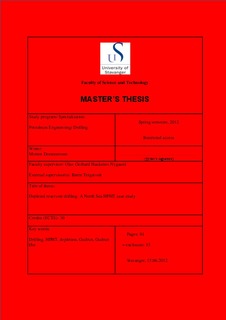| dc.contributor.author | Dommersnes, Morten | |
| dc.date.accessioned | 2014-02-06T09:43:46Z | |
| dc.date.available | 2014-02-06T09:43:46Z | |
| dc.date.issued | 2012-06 | |
| dc.identifier.uri | http://hdl.handle.net/11250/183672 | |
| dc.description | Master's thesis in Petroleum engineering | no_NO |
| dc.description.abstract | Drilling infill wells in HPHT fields can represent a severe challenge. Narrow drilling windows are prevailing in HPHT reservoirs, and pressure depletion will decrease this window even more. It may be critical to drill planned wells as soon as possible after production from the field is initiated because depletion is known to be rapid in HPHT reservoirs.
More complex wells and narrow drilling windows may result in more non-productive time (NPT). This is not a wanted situation, especially since the operational costs has increased dramatically during the recent years. Wellbore stability issues are known to be a large contributor to NPT in the oil industry. Conventional drilling methods may not be the best solution in situations with a limited drilling window. In this study was the following technologies found to have potential advantages with respect to depleted reservoir drilling:
Conventional drilling
Lost circulation materials
Managed pressure drilling
Underbalanced drilling
Casing drilling
Liner drilling
Expandable liners
Combination of drilling liner and expandable liner
Lining while drilling method patented by BP
Gudrun is a HPHT light oil/condensate field located in block 15/3 in the North Sea. Pressures up to 815 bars and temperatures up to 170 C are expected. Gudrun Øst is a relatively small discovery located approximately 4 km south east of the Gudrun field. The discovery has been implemented in the Gudrun project, and a 6988 meter long horizontal well is planned to be drilled to Gudrun Øst. Production is planned to be initiated from the target reservoir, Draupne 3, before the well is drilled. Initiating production may lead to severe depletion of the reservoir and make the drilling operation to Gudrun Øst difficult to perform.
Conventional drilling of the well to Gudrun Øst was simulated in the Presmod module of Drillbench, with different depletion scenarios. Presmod includes a dynamic temperature model, which makes it more accurate in HPHT environments. The goal was to simulate representative ECDs, and use the results to determine when conventional drilling is no longer applicable for drilling A-14. Simulations were first carried out on a well that was already drilled on Gudrun to verify the accuracy of the model. A good match was achieved between simulated and measured ECDs. The simulated values were less than 0.01 sg from the measured values.
Conventional drilling was found to be applicable for drilling A-14 in situations with 60 bars depletion or less based on theory, experiences and simulation results. Lost circulation materials should be considered to be included in the mudsystem if the depletion exceeds 40 bars depletion. It is recommended to use managed pressure drilling technology if the expected depletion is between 60 and 120 bars. More extensive studies have to be carried out to determine the drillability of the well if the depletion exceeds 120 bars. Underbalanced drilling may be the only applicable solution in this situation. | no_NO |
| dc.language.iso | eng | no_NO |
| dc.publisher | University of Stavanger, Norway | no_NO |
| dc.relation.ispartofseries | Masteroppgave/UIS-TN-IPT/2012; | |
| dc.subject | petroleumsteknologi | no_NO |
| dc.subject | boreteknologi | no_NO |
| dc.subject | drilling | no_NO |
| dc.subject | hpht | no_NO |
| dc.subject | depletion | no_NO |
| dc.subject | | no_NO |
| dc.subject | Gudrun øst | no_NO |
| dc.title | Depleted reservoir drilling: A North Sea HPHT case study | no_NO |
| dc.type | Master thesis | no_NO |
| dc.subject.nsi | VDP::Technology: 500::Rock and petroleum disciplines: 510::Petroleum engineering: 512 | no_NO |
